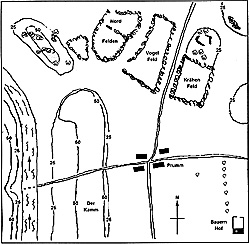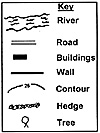About 3 years ago I acquired "Follow the Eagle" and in a burst of wild enthusiasm started of with the battle of Smolensk. Building the Order of Battle (OB) took what seemed to me ages. When I started to play - solo- I found could not remember which units I had and was constantly searching through the printout to discover who reported to whom.
I realised that I had bitten off more than I could chew it all wanted to do initially was learn the system. I therefore went over to a simplified made up OB and a fictional location. For details of both see below. The map is made up from my own permanent sectional terrain. but one similar is easily arranged. I have since found this scenario - naturally called Cross-roads - roughly based on Quatre Bras - very useful to introduce War games into the system who had never before played a computer supported figure game. To this end it has been quite successful and so offer it to others for the same purpose. It also gives a good game on it's own merits. So far the honours have been equal with the French winning as often as their opponents so the scenario seems well balanced.
Positioning
 The Anglo-Allied force is positioned on Der Kamm whilst the French come in from the Eastern table edge. The French objective is to drive the Anglo-Allied force off Der Kamm and so gain possession of the ford over Der Fluss.
The Anglo-Allied force is positioned on Der Kamm whilst the French come in from the Eastern table edge. The French objective is to drive the Anglo-Allied force off Der Kamm and so gain possession of the ford over Der Fluss.
The table is 40 inches square. Troops were used in blocks each roughly representing 200 cavalry, or 300 infantry, or 4 guns.
When not using their own figures, I had found that friends had difficulty in identifying units. Although all were marked on the underside with a unit description looking up unit designations slowed down the play and led to confusion. For this game, in which I used units of all the types found in Napoleonic warfare as part of the learning process. I put on the table figures which could be sight identified for what they were by their uniforms or their posture.
Sight Identified
 For example the differences between the 1st Dragoons and the 25th Dragoons were that the 1st had helmet plumes, were waving their swords in the air, sat on charging horses and had their red cape linings turned outward on top of the portmanteau. The 25th, apart from their orange facings, were on walking horses, no helmet plumes, and orange cape linings.
For example the differences between the 1st Dragoons and the 25th Dragoons were that the 1st had helmet plumes, were waving their swords in the air, sat on charging horses and had their red cape linings turned outward on top of the portmanteau. The 25th, apart from their orange facings, were on walking horses, no helmet plumes, and orange cape linings.
Every infantry unit was slightly different in posture or uniform. have deliberately painted all my French Legere units in all blue uniforms rather than some of the variations that could confuse them with my French Ligne, and used different coloured shako covers in some cases. Between battalions of the same regiment different coloured bases are used. Artillery units also have differently coloured bases. Players of average memory therefore only needed to identify a unit once at the beginning of a game.
My forces are recruited from Heroics and Ros. Irregular Miniatures, and Eagle Six, though I must admit I acquired the latter when they were first marketed by Minifigs. I differentiate between similar looking Eagle Six blocks by adding standards to them, by their facings, and by adding and colouring bases. I found them quick and easy to paint.
For this scenario I used a ground scale of 1:3600 (1" = 100 yards). I have organised many of my units so that if I want to use a ground scale of 1:1800 a regiment becomes a battalion. and in the event of using 1:900 (1" = 25 yards) a brigade becomes a battalion. This latter is achieved by having some brigades made up of battalions all from one regiment.
For the reasons quoted in my article IN-FORMATION ( see First Empire 12 July/August 93 ) my infantry companies organised on French lines have 4 figures to a 15mm base at a ground scale of 1:1800, as do British troops. Other nationalities frontages vary according to strengths and organisations. I have standardised cavalry frontages at strong squadrons of 20mm on which I place three figures. One model artillery piece represents 4 guns on a 20mm x 13mm base. Limbers and teams are on a separate base. Frontages of cavalry and artillery could also be varied according to nationality for those wishing greater realism. The actual strengths of each battalion for any particular battle are built into the "Follow the Eagle" program.
I trust all this will give you a good war game.
Bon Chance.
Suggested Order of Battle for the Cross-roads Scenario
Armee du Nord - 7,440 Men, 22 Guns
Commander in Chief : Marechal d'Empire Ney
Corps: Prince Eugene Division: General de Division MorandBrigade: General de Brigade Doual
- 1st Battalion 13th Legere 840
2nd Battalion 13th Legere 840
3rd Battalion 13th Legere 840
10th Coy 6pdr Foot Artillery Regt 8
- Brigade Totals 25,203 Infantry, 0 Cavalry, 8 Guns.
Brigade: General de Brigade Desailly
- 1st Battalion 12th Ligne 840
2nd Battalion 12th Ligne 840
3rd Battalion 12th Ligne 840
8 Coy 10th Foot Artillery Regt 8
- Brigade Totals 2,520 Infantry, 0 Cavalry, 8 Guns.
Division: General de Division l'Heritier
Brigade: General de Brigade Dufour
- 1st Dragoons 800
25th Dragoons 800
- Brigade Totals 0 Infantry, 1,600 Cavalry, 0 Guns.
Brigade: General de Brigade Rigaud
- 1st Cuirassiers 800
Blaque's 6 pdr Horse Artillery Battery 6
- Brigade Totals 0 Infantry, 800 Cavalry, 6 Guns.
- General de Brigade Gourgaud
Captain d'Artagnan
General de Division Duval
Allied Army - 5,444 MEN, 16 Guns
Commander in Chief: Duke of Wellington
Corps: Duke of Brunswick Division: General KielmannBrigade: General de Brigade Howarth
- Avant Garde 690
1st Battalion 95th Rifles 418
- Brigade Totals 1,108 Infantry, 0 Cavalry, 0 Guns.
Brigade: General de Brigade von Buttlar
- 1st Brunswick L.I. 988
2nd Brunswick L.I. 988
- Brigade Totals 1,976 Infantry, 0 Cavalry, 0 Guns.
Brigade: General de Brigade von Specht
- 1st Brunswick Line 692
2nd Brunswick Line 692
v. Moll Foot Artillery Battery 8
- Brigade Totals 1,384 Infantry, 0 Cavalry, 8 Guns.
Brigade: General de Brigade Cramm
- 16th Light Dragoons 727
v. Heineman Horse Artillery 6pdr Battery 8
Brunswick Uhlans 249
- Brigade Totals 0 Infantry, 976 Cavalry, 8 Guns.
- Major von Wachhlotz
Back to Table of Contents -- First Empire #21
Back to First Empire List of Issues
Back to MagWeb Master Magazine List
© Copyright 1997 by First Empire.
This article appears in MagWeb (Magazine Web) on the Internet World Wide Web. Other military history articles and gaming articles are available at http://www.magweb.com